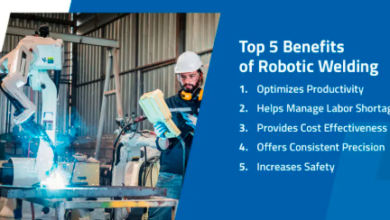All About Physical Access Control System
In today’s world, keeping critical information secure is very important for every organization. That is why many businesses use what is known as a “physical access control system.” It’s like a way to ensure that only the right people have access to areas where essential items and information are maintained. It’s not just about locks and keys; it’s a comprehensive system that allows businesses to regulate who has access to specific areas. This article will discuss what this system is all about and why installing an physical entry control system is vital. We’ll explain and discuss everything in detail. So, keep on reading if you want to learn more about keeping things secure!
What Is Physical Access Control Security?
Let’s begin with a basic definition: what are physical access controls and physical access control security? Consider physical access controls such as customized locks for buildings or specific facility areas. These locks determine who may enter and who cannot.
Installing an physical entry control system ensures that only authorized individuals can enter. As a result, it keeps bad guys out while allowing the right people in. It also makes it easier for people to move around a building if permitted to be there. Now, different people may have distinct permissions, such as a unique key that only works in specific locations. This contributes to the security of critical and significant places where it is vital to ensure that only the correct type of people and individuals can enter.
Access levels are very much like various levels of permission. Some people have more authority, such as bosses or contractors, whereas others have less permission. This determines which areas of a building they are permitted to enter. For example, everyone may use their card or PIN to enter the main door. Still, only specific people may be able to visit particular areas containing secret or vital information.
Previously, security guards would decide who could and could not enter a location. However, with time, things have become more digital. In today’s era, primarily, people use unique cards or key fobs, as well as PINs, instead of standard keys. These are precisely known as physical access control systems. They provide you with complete control over who can access your building.
What Are Its Components?
This access system consists of several interconnected components. Here are a few of these:
1. Entry Points: These are the doors and gates where we install unique locks to keep intruders out. Examples include standard locks, turnstiles, and gates.
2. Identifying Yourself: To gain entry, you must prove you are authorized. A special card, a PIN, a mobile app, a password, or a fingerprint or face might be used. Some also use special badges or license plate recognition.
3. Readers: Consider it like you have a special card or code that allows you to enter a location. When you go up to a door, a gadget reads your card or code. After that, the device sends the information to a control panel, which selects whether or not you can enter.
4. Control panel: The control panel receives information from the device and determines whether or not you are authorized to enter. If your card or code is valid, the door will open for you. But if it’s not correct, you won’t be able to enter.
5. Access control server: A particular computer records everyone’s cards, codes, and when they enter. This computer could be located in the same building or the cloud (similar to the internet). It keeps things organized and lets those in charge know who came in and who didn’t.
To function, the security system must connect with doors with electronic locks. These locks can be set to unlock automatically when the appropriate cards or codes are used. You can choose between two types of locks: those that remain locked if anything goes wrong (fail-secure) and those that open if something goes wrong (fail-safe). You may be required to use a specific type of lock depending on the requirements for safety and security. For example, doors used to enter a place should have locks that open in an emergency so everyone can immediately exit.
Methods Of Authentication
There are various methods of authentication as far as installing an physical entry control system is concerned. Following are a few of these.
1. Key Fobs or Cards: Cards and critical fobs are two methods for proving your identity while entering a building. These are similar to special keys that can be programmed to only work for specific people and locations within a facility. They can also be used to operate office equipment such as printers. However, these cards or key fobs might be lost, and it can be difficult to tell if the person using them is the correct person. As a result, if someone isn’t supposed to get someone’s card, they may be able to enter restricted places.
2. Mobile Phones: You can utilize phone apps to demonstrate that you have permission to enter a location. Various workers can have varying access levels, and the boss can update the app. Phones, like cards, can be misplaced. Fortunately, most phones feature locks or unique checks that keep hackers out even if they gain access to someone’s phone.
3. Biometrics: You can confirm your identity using distinctive physical traits such as your face, fingerprint, eye, or hand. Because these things are unique to each individual, they are difficult to replicate. However, this approach is considered to be more expensive than other methods of entry.
Its Importance
Installing an physical entry control system has the significant advantage of making places safer. When you have this system in place, it makes it more difficult for people who shouldn’t be there to gain access. It also allows those in charge to determine who can and cannot enter a building.
This technique is highly beneficial in preventing security issues, whether they originate within the organization or outside sources. According to 2022 research, mishaps caused by employees increased by 44% in the last two years, with each occurrence costing approximately $15.38 million.
This approach is also beneficial for following the rules, particularly in healthcare-related industries. It is critical to protect rooms that contain sensitive information, and having this system in place helps healthcare facilities follow the requirements and keep patient information secure.
What To Look For?
When deciding who can enter your place, keep the following points in mind to ensure that you do it correctly:
1. Level of Security: Consider what people will use to prove their eligibility. Some methods, such as key cards or fobs, are more easily misplaced or shared. These are riskier. Other methods, such as biometrics or mobile technology, are more challenging to track and considered safer.
2. Easy to Apply: The mechanism you employ to control who comes in should be simple. It should allow those in control to rapidly grant or reject access, as well as handle emergencies such as locking down the building. It’s also beneficial if they can obtain information on how people are coming in.
3. Can Grow Alongside You: If you intend to expand your business, the system you utilize should be able to grow with you. A good solution lets you easily add new doors and places to your control list by clicking a few times.
Final Thoughts
There is no denying the fact that having a solid physical access control system can prove to be highly beneficial for organizations. If you want to secure your place in the best manner possible, it is recommended to have this system installed.




